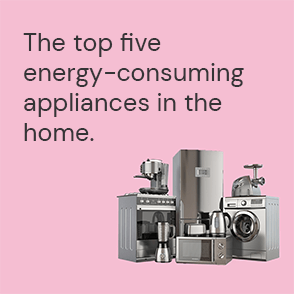ENERGY BILL
The top five
energy-consuming
appliances in the home.
Some of the most energy-hungry appliances in your home are the ones you use every day. From air conditioners to hot water systems, some household appliances are more costly to run than others.
But fear not; here, we share the top five energy-consuming appliances in the home and ways to lower your energy consumption without sacrificing comfort or convenience.
Whether you're a seasoned energy-saver or just starting to explore ways to save, there's something for everyone.
-
Air conditioners
With air conditioning accounting for 62% of an average Canberran household's energy use, they are one of the most energy-hungry appliances in the home. When they're on for most of the day, their use can add to your bill.
When heating your home, consider adjusting the temperature down slightly, as a 1% increase can add up to 10% of the energy use. The smaller the difference between the ambient and desired temperatures means your heating doesn't have to work as hard, resulting in energy savings. Wearing an extra layer of clothing during the day or swapping your quilt for a heavier weight when you sleep can ensure you remain comfortable while slightly reducing the temperature of your heating and conserving energy.
When cooling your home, use a ceiling fan in conjunction with your air conditioning to save. It will allow you to set your air conditioning at a slightly higher temperature reducing the energy it uses while the ceiling fan efficiently circulates the cooler air.
-
Clothes dryers
Electrical appliances like clothes dryers account for 15% of an average Canberran household's energy use. A typical vented clothes dryer consumes around 2.2 to 4.5 kWh of electricity per load. Heat pump dryers are generally more energy-efficient, averaging approximately 1.5 to 3.5 kWh per load.
To save on your clothes dryer use, opt to use the clothesline when the sun is shining, avoid using your clothes dryer as an iron and ensure you programme your dryer to finish once the load is dry so it doesn't continue to run unnecessarily.
-
Electric ovens
Electric ovens can use a lot of energy to generate heat. So, if you cook frequently, your electric oven and cooktop can be one of the biggest energy consumers in your home. For example, a typical electric oven with a capacity of 60-80 litres and a power rating of 2.5-3.5 kW will consume around 0.8-1.2 kWh of electricity per hour.
To lower your cooking costs, consider swapping the oven for your induction cooktop, slow cooker, microwave, or air fryer - recipe permitting.
Slow cookers typically use around 100 watts or less – which means they can cook food for hours on end while using a fraction of the energy required by other cooking methods, so they are a great kitchen appliance for anyone looking to save time and energy while cooking.
Air fryers use hot air for cooking food, similar to a convection oven, but on a smaller scale which means they heat up much faster than an oven, requiring less energy to reach the desired temperature. Further, an air fryer is much smaller than an oven, requiring less energy to heat the cooking space, which is particularly useful if you're cooking for one or two people and don't need a large oven.
-
Pool filters
For some Australian homes, the pool pump can be one of the largest electricity users, making up around 18% of its electricity bill.
Pool pumps often need to run around eight hours a day, so the cost can add up, particularly over summer when your pool is in use. However, by using a programmable pool pump, you can schedule it to run during off-peak times when energy costs are lower. According to actsmart.gov.au, you could reduce your pool pump operating costs by as much as 40%.
Further, pool pumps are often set to run for longer than necessary, which can increase your energy bill. Set your pool pump timer to run for a shorter period and adjust it based on your usage patterns. Once you have implemented these tips, monitor your pool, maintain its operation, change the settings as needed and watch the savings.
-
Hot water systems
Water heaters are responsible for heating the water you use for showers, washing dishes and doing laundry. Water heaters account for around 16% of an average Canberran household's energy use, so they are particularly energy-intensive, especially if they are not insulated or have a low energy efficiency rating.
Most hot water systems are set to 50 – 60 degrees. By keeping your temperature on the lower end of the scale, you can reduce the energy used to keep the water warm. Often, we mix hot water with cool when we shower, so a reduction in temperature may still be comfortable and go largely unnoticed.
Some hot water systems contain a mode of operation which allows you to choose between 'normal', which provides a constant stream of hot water and 'eco', which conserves energy by reducing the temperature.
Timers are common on hot water systems and allow you to turn the hot water system on and off at specific times, such as peak and off-peak, so water is only being heated when likely to be used.
By understanding these settings, you may be able to optimise your hot water system and subsequent usage so you can manage your hot water system to save.
Summary
- Heating and cooling using an air conditioner accounts for 62% of an average Canberran household's energy use.
- Electrical appliances like clothes dryers account for 15% of an average Canberran household's energy use.
- Cooking accounts for 3% of an average Canberran household's energy use.
- A pool pump accounts for around 18% of an average Australian household's energy use.
- Water heaters account for around 16% of an average Canberran household's energy use.
ActewAGL's energy saving tips are designed to help you take control of your energy use, while reducing your bills and environmental impact. Save with great value energy plans backed by our sustainability promise, supported by 100% local, award-winning service.
Sources
https://www.actsmart.act.gov.au
https://www.energyrating.gov.au/consumer-information/products/clothes-dryers
https://www.energy.gov.au/households/pool-pumps
Disclaimer: These Energy Savings tips and articles are for information purposes only. Please ensure you are aware of any safety precautions before operating appliances or products.




